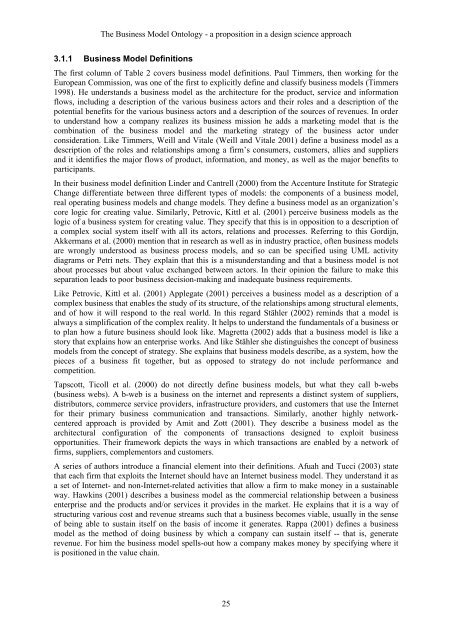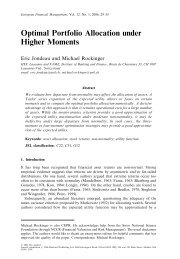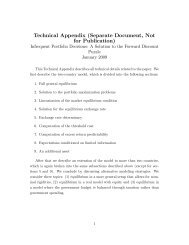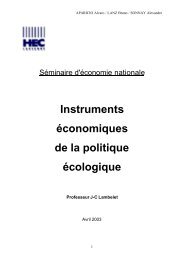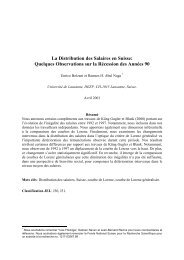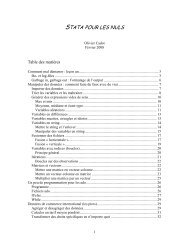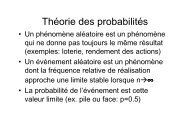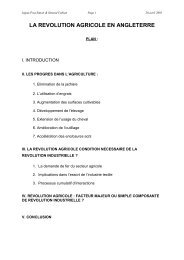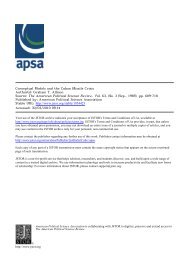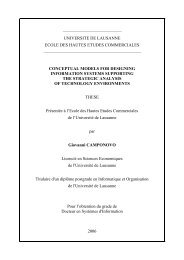The Business Model Ontology - a proposition in a design ... - HEC
The Business Model Ontology - a proposition in a design ... - HEC
The Business Model Ontology - a proposition in a design ... - HEC
You also want an ePaper? Increase the reach of your titles
YUMPU automatically turns print PDFs into web optimized ePapers that Google loves.
<strong>The</strong> <strong>Bus<strong>in</strong>ess</strong> <strong>Model</strong> <strong>Ontology</strong> - a <strong>proposition</strong> <strong>in</strong> a <strong>design</strong> science approach<br />
3.1.1 <strong>Bus<strong>in</strong>ess</strong> <strong>Model</strong> Def<strong>in</strong>itions<br />
<strong>The</strong> first column of Table 2 covers bus<strong>in</strong>ess model def<strong>in</strong>itions. Paul Timmers, then work<strong>in</strong>g for the<br />
European Commission, was one of the first to explicitly def<strong>in</strong>e and classify bus<strong>in</strong>ess models (Timmers<br />
1998). He understands a bus<strong>in</strong>ess model as the architecture for the product, service and <strong>in</strong>formation<br />
flows, <strong>in</strong>clud<strong>in</strong>g a description of the various bus<strong>in</strong>ess actors and their roles and a description of the<br />
potential benefits for the various bus<strong>in</strong>ess actors and a description of the sources of revenues. In order<br />
to understand how a company realizes its bus<strong>in</strong>ess mission he adds a market<strong>in</strong>g model that is the<br />
comb<strong>in</strong>ation of the bus<strong>in</strong>ess model and the market<strong>in</strong>g strategy of the bus<strong>in</strong>ess actor under<br />
consideration. Like Timmers, Weill and Vitale (Weill and Vitale 2001) def<strong>in</strong>e a bus<strong>in</strong>ess model as a<br />
description of the roles and relationships among a firm’s consumers, customers, allies and suppliers<br />
and it identifies the major flows of product, <strong>in</strong>formation, and money, as well as the major benefits to<br />
participants.<br />
In their bus<strong>in</strong>ess model def<strong>in</strong>ition L<strong>in</strong>der and Cantrell (2000) from the Accenture Institute for Strategic<br />
Change differentiate between three different types of models: the components of a bus<strong>in</strong>ess model,<br />
real operat<strong>in</strong>g bus<strong>in</strong>ess models and change models. <strong>The</strong>y def<strong>in</strong>e a bus<strong>in</strong>ess model as an organization’s<br />
core logic for creat<strong>in</strong>g value. Similarly, Petrovic, Kittl et al. (2001) perceive bus<strong>in</strong>ess models as the<br />
logic of a bus<strong>in</strong>ess system for creat<strong>in</strong>g value. <strong>The</strong>y specify that this is <strong>in</strong> opposition to a description of<br />
a complex social system itself with all its actors, relations and processes. Referr<strong>in</strong>g to this Gordijn,<br />
Akkermans et al. (2000) mention that <strong>in</strong> research as well as <strong>in</strong> <strong>in</strong>dustry practice, often bus<strong>in</strong>ess models<br />
are wrongly understood as bus<strong>in</strong>ess process models, and so can be specified us<strong>in</strong>g UML activity<br />
diagrams or Petri nets. <strong>The</strong>y expla<strong>in</strong> that this is a misunderstand<strong>in</strong>g and that a bus<strong>in</strong>ess model is not<br />
about processes but about value exchanged between actors. In their op<strong>in</strong>ion the failure to make this<br />
separation leads to poor bus<strong>in</strong>ess decision-mak<strong>in</strong>g and <strong>in</strong>adequate bus<strong>in</strong>ess requirements.<br />
Like Petrovic, Kittl et al. (2001) Applegate (2001) perceives a bus<strong>in</strong>ess model as a description of a<br />
complex bus<strong>in</strong>ess that enables the study of its structure, of the relationships among structural elements,<br />
and of how it will respond to the real world. In this regard Stähler (2002) rem<strong>in</strong>ds that a model is<br />
always a simplification of the complex reality. It helps to understand the fundamentals of a bus<strong>in</strong>ess or<br />
to plan how a future bus<strong>in</strong>ess should look like. Magretta (2002) adds that a bus<strong>in</strong>ess model is like a<br />
story that expla<strong>in</strong>s how an enterprise works. And like Stähler she dist<strong>in</strong>guishes the concept of bus<strong>in</strong>ess<br />
models from the concept of strategy. She expla<strong>in</strong>s that bus<strong>in</strong>ess models describe, as a system, how the<br />
pieces of a bus<strong>in</strong>ess fit together, but as opposed to strategy do not <strong>in</strong>clude performance and<br />
competition.<br />
Tapscott, Ticoll et al. (2000) do not directly def<strong>in</strong>e bus<strong>in</strong>ess models, but what they call b-webs<br />
(bus<strong>in</strong>ess webs). A b-web is a bus<strong>in</strong>ess on the <strong>in</strong>ternet and represents a dist<strong>in</strong>ct system of suppliers,<br />
distributors, commerce service providers, <strong>in</strong>frastructure providers, and customers that use the Internet<br />
for their primary bus<strong>in</strong>ess communication and transactions. Similarly, another highly networkcentered<br />
approach is provided by Amit and Zott (2001). <strong>The</strong>y describe a bus<strong>in</strong>ess model as the<br />
architectural configuration of the components of transactions <strong>design</strong>ed to exploit bus<strong>in</strong>ess<br />
opportunities. <strong>The</strong>ir framework depicts the ways <strong>in</strong> which transactions are enabled by a network of<br />
firms, suppliers, complementors and customers.<br />
A series of authors <strong>in</strong>troduce a f<strong>in</strong>ancial element <strong>in</strong>to their def<strong>in</strong>itions. Afuah and Tucci (2003) state<br />
that each firm that exploits the Internet should have an Internet bus<strong>in</strong>ess model. <strong>The</strong>y understand it as<br />
a set of Internet- and non-Internet-related activities that allow a firm to make money <strong>in</strong> a susta<strong>in</strong>able<br />
way. Hawk<strong>in</strong>s (2001) describes a bus<strong>in</strong>ess model as the commercial relationship between a bus<strong>in</strong>ess<br />
enterprise and the products and/or services it provides <strong>in</strong> the market. He expla<strong>in</strong>s that it is a way of<br />
structur<strong>in</strong>g various cost and revenue streams such that a bus<strong>in</strong>ess becomes viable, usually <strong>in</strong> the sense<br />
of be<strong>in</strong>g able to susta<strong>in</strong> itself on the basis of <strong>in</strong>come it generates. Rappa (2001) def<strong>in</strong>es a bus<strong>in</strong>ess<br />
model as the method of do<strong>in</strong>g bus<strong>in</strong>ess by which a company can susta<strong>in</strong> itself -- that is, generate<br />
revenue. For him the bus<strong>in</strong>ess model spells-out how a company makes money by specify<strong>in</strong>g where it<br />
is positioned <strong>in</strong> the value cha<strong>in</strong>.<br />
25


